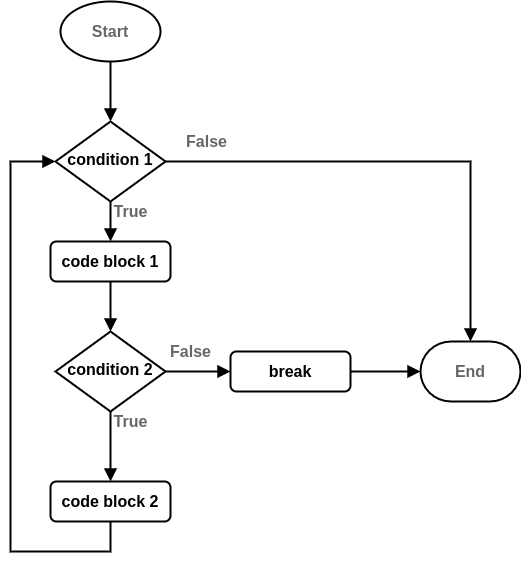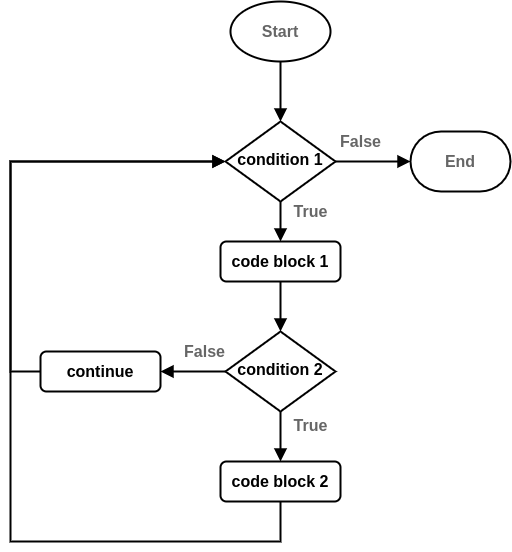Breaking Out of Loops¶
Sometimes you want to exit a loop before it’s finished, or skip the remainder of a loop and move to the next iteration. To do this you can use the break and continue statements respectively.
break¶
The break statement causes control to exit the loop it is situated in. For example, if we were to put a break directly in the loop’s code block:
for i in range(5):
print(i)
break
0
You can see that only the first loop iteration completed.
Let’s illustrate this with a pseudo code example:
while condition1:
code_block_1
if condition2:
break
code_block_2
In the example above condition2 is evaluated as true in a loop iteration, then control will exit the loop before executing code_block_2 for that iteration.
Illustrating this using a control flow diagram:

Fig. 16 Control flow diagram of the break example above.¶
Let’s consider a similar script that loops through a sequence of numbers and stops when it reaches 5:
for i in range(10):
print(i)
if i == 5:
break
print('next iteration')
0
next iteration
1
next iteration
2
next iteration
3
next iteration
4
next iteration
5
As you can see in the example above the loop terminated before it finished iterating through range(10). When i had a value of 5 the break statement was called, exiting from the loop.
Note that it doesn’t matter that the break is nested in an if statement, it will always make control exit the nearest loop that it is nested in.
The break statement exits the first loop that it’s nested in. For example, if we had multiple nested loops:
for i in range(3):
print('Loop1', i)
for j in range(3):
print(' Loop2', j)
if j == 1:
break
Loop1 0
Loop2 0
Loop2 1
Loop1 1
Loop2 0
Loop2 1
Loop1 2
Loop2 0
Loop2 1
We can see that the outer loop (Loop1) iterated through all of range(3), while Loop2 terminates before it can reach the last iteration.
continue¶
If you want to end the current loop iteration, but you don’t want to break out of the loop, you can use the continue statement.
Consider the pseudo code example:
while condition1:
code_block_1
if condition2:
continue
code_block_2
Here if condition2 is found to be true in a loop iteration, the continue statement will cause control to move directly to the next loop iteration, skipping code_block_2 for that iteration.
Illustrating this example in a control flow diagram:

Fig. 17 Control flow diagram of the continue example above.¶
Let’s look at real code example:
for i in range(10):
if i == 5:
continue
print(i)
0
1
2
3
4
6
7
8
9
As you can see in the example above, 5 is not printed as the continue statement has caused control to ‘skip’ the print statement.
